Oberlin Alumni Magazine
Cream of the Crop
Third-generation dairy farmer Sarah Lyons Chase ’10 is milking to the beat of a different drummer—and thriving in the process.
June 24, 2024
Hannah Van Sickle
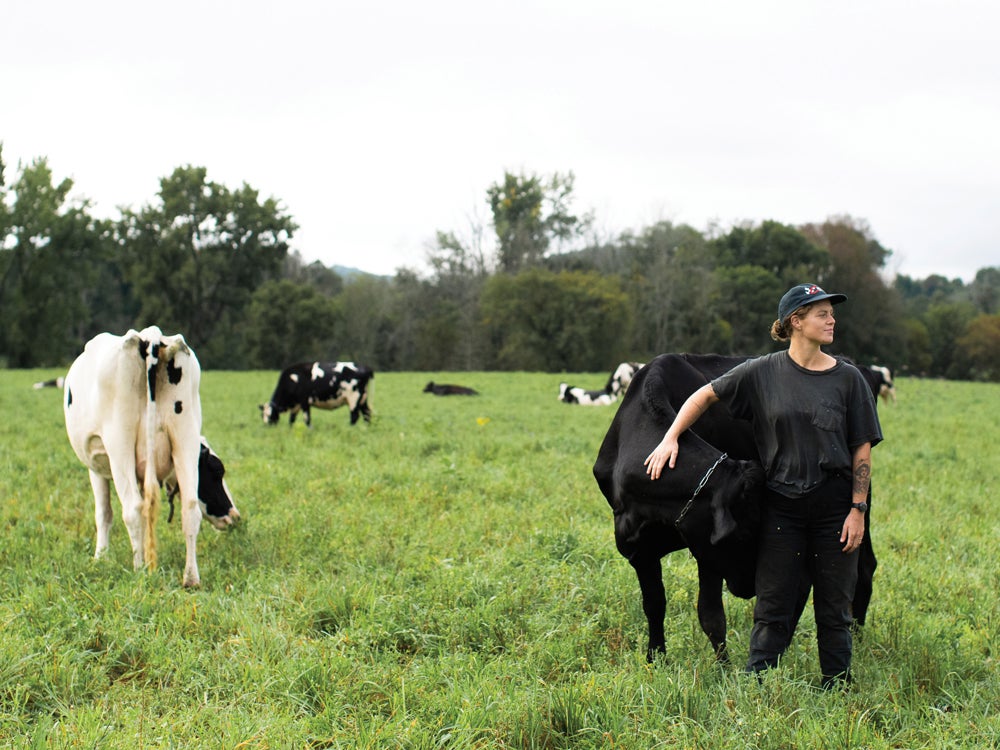
“Working at the creamery helped me realize there was a different direction worth exploring in dairy,” says Chase, who made cheese with her brother, Rory, following graduation.
Photo credit: Jennifer Young Studio
Upstate New York in October is a feast for the senses. It’s a region with a rich history of agriculture that’s rife with rolling hills in hues of green and gold as far as the eye can see, punctuated by grain silos and plastic-wrapped hay bales dotting the soon-to-be-fallow fields. Brittle corn stalks rustle in the breeze, and the staghorn sumac is ablaze, its crimson canopy undulating in step with the surrounding landscape.
Transition abounds especially throughout the Hudson Valley’s Dutchess County, an area spanning 78 square miles of hilly terrain bordered by the Taconic Mountains and the Hudson Highlands, where hand-lettered signs boast the last of summer’s sweet corn and advertise pick-your-own apples. Dutchess County is also the home of Pine Plains, a rural hamlet named for the abundance of conifers still dotting the valley. Located 94 miles from New York City, Pine Plains was founded in 1823 and is home to a scant 2,200 people. Save for dairy farming and horse breeding, its biggest claim to fame is the fact that Barnum and Bailey Circus once housed its show animals at local farms during the winter.
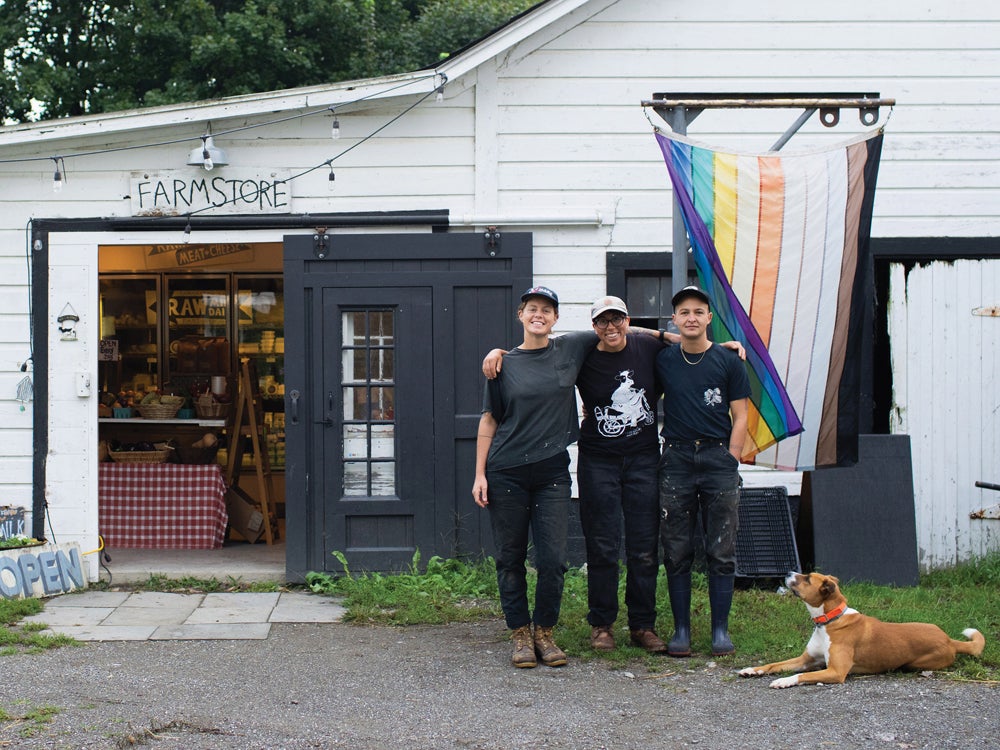
The Chase family has bred dairy cattle for three generations at Chaseholm Farm, located on a sprawling 330-acre tract of fertile land northeast of Pine Plains proper. Following in the footsteps of her father and late grandfather, Sarah Lyons Chase ’10 took over the business in 2013 and became a farmer at age 24.
A decade later, she’s turned Chaseholm Farm into a 100% grass-fed, USDA-certified organic dairy—and she’s now milking every last drop out of a lifestyle that, in large part, has become unsustainable for many young farmers like herself. Across the Hudson Valley, small dairies are falling by the wayside, a byproduct of rising costs and dwindling profits. For a conventional dairy farmer, producing a gallon of milk costs more than it yields when sold to the dairy cooperative. That she owns and runs Chaseholm Farm is a rarity: According to the American Farmland Trust, only 4.1% of dairy operations in the United States have a woman as principal operator. On many fronts, Chase has slowly parted ways with tradition in favor of forging her own path —one paved with intention at every turn.
Ecology, Economy, Engagement
As a new farmer, Chase’s main goal was to prioritize the ecology of her land by implementing holistic land management. It’s a seismic shift imbued with reciprocal benefits for her animals, the land, and those stewarding it for the next generation.
A whole-farm planning system introduced by ecologist Allan Savory in the early ’80s, holistic land management helps farmers better manage agricultural resources in order to reap sustainable benefits. Environmentally, this means using the animals to heal the land (in lieu of harmful fertilizers and pesticides); economically, this translates to crafting a product (in Chase’s case, 100% grass-fed milk) that consumers will pay her a living wage to produce; and socially, it boils down to hosting regular events—things like live music, burger nights, and honky tonks —aimed at connecting neighbors and building community.
“You have to adapt and change,” says Chase, clad in a black zip-up hoodie, blue jeans, and baseball cap, her ginger-hued hair brushing against freckled cheeks in the breeze.
This method asked me to think about what I wanted from my life, and I was primarily interested in working with these animals that I love to make a positive impact on this land that means so much to me.
She’s standing outside the modest, milk-white dairy barn her grandfather built in the 1930s. From within the 33-stall space, which serves as the farm’s winter housing and milking parlor, the quiet lowing of dairy cattle at rest mingles with the rhythmic pulsing of a suction-based pipeline milking system and swishing tails swatting at lazy stable flies. It’s just after 9:00 in the morning, and Chaseholm Farm’s milking manager is making quick work of emptying each cow’s swollen udder so the animals can get back to doing what they do best: grazing on grass.
“My herd has to go out and work for their food as nature intended,” Chase says. It’s a delightfully simple big-picture process: As they graze, the animals simultaneously fertilize the fields, work their manure into the ground, and stimulate new growth before moving onto fresh pasture rich with forage, the diverse array of plants, grass, and legumes they eat. After a period of rest and regrowth for the pasture, the herd returns to the same location, now lush with fresh forage.
Switching up the herd’s feeding habits is just one change Chase made at Chaseholm Farm. What began with healing the land led to a fascination with cattle genetics, as evidenced by the farm’s most prized players: a herd of 25 spotted Holstein-Jersey cows of her own design, born with the grass-specific genetics needed for the animals to prosper on forage. These bovines don’t resemble conventional dairy cows: They’ve adapted to their environs by becoming lower to the ground, developing bigger muzzles, and increasing their rumen capacity. “The goal is a healthy cow that can produce a decent amount of milk on grass alone,” Chase explains, noting each cow averages 35 pounds (roughly 4 gallons) daily.
Having made huge strides in replenishing degraded soil, improving ecosystem function, and building biodiversity, Chase set to work on her next goal: breaking the long-held tradition of milking at sunrise and sunset. The seemingly unconventional decision irrevocably changed her life as a dairy farmer. During 2018’s particularly wet fall, Chase watched as her herd struggled to navigate the muddy laneways en route to pasture. Not only did they expend extra calories while covering a significant distance to reach their destination, they also had to turn around within hours to be milked.
Chase and her team quickly started employing a different schedule: milking at 6 a.m. and 6 p.m. one day, followed by milking at noon the next, before returning to 6 a.m. the day after that. Eventually, both weekend days became noon milking days, to the delight of employees who came to enjoy something unheard of in the dairy business: regular hours that don’t require them to rise before dawn. In November 2022, Chase made a final push to adopt a once-a-day milking schedule across the board. After running the numbers, she discovered only a negligible reduction in milk production.
Family Business
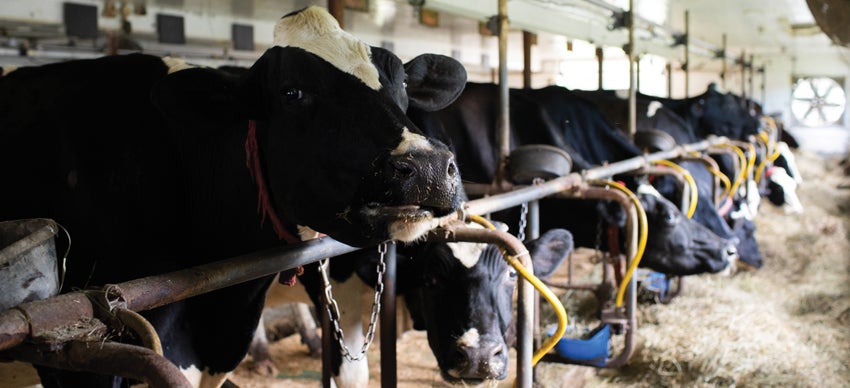
Chase remains an early riser by choice as opposed to necessity. Day-to-day tasks vary according to the season and can include mending fences, mowing fields, raising bulls, and harvesting the beef cattle—all done with an eye toward increasing efficiency and building a rewarding way of life.
Each morning, Chase’s older brother, Rory, buys the bulk of Chaseholm Farm’s raw milk for Chaseholm Farm Creamery, which he founded in 2007. At the on-site Farm Store, multiple flavors from the creamery’s cheese aging cave—including Chaseholm Camembert and Nimbus Triple Cream—keep company in self-serve coolers with whole-milk yogurt, raw milk, and diverse cuts of meat. This sales practice positions the pair of savvy farmers at the helm of what has become a burgeoning business model not only in the Hudson Valley, but also across the country: working in concert with the land and animals to create hyper-local products and selling directly to the consumer.
Keeping things all in the family is nothing new for Chaseholm Farm. It’s been a working dairy farm since the early 1930s when Chase’s grandfather, Dr. Kenneth Fulton Chase—a prominent local dentist and dairyman—combined a trio of smaller farms to create Chaseholm. (The moniker is based on a Dutch word meaning “an island unto itself.”) Chase’s father, Kenneth Barrett “Barry” Chase, took over after his father’s 1971 death and ran the farm for 36 years.
The youngest of three children, Sarah Chase was the sibling keenest on pitching in to help her dad on the farm. She learned to milk using her grandfather’s tried-and-true dump-station milking system and fondly recalls receiving a serendipitous gift on her 10th birthday: a dairy calf named Maywine. But despite this growing interest in the farm’s day-to-day operations, Chase felt no obligation to stay home and take over the reins. In fact, she was encouraged by her parents to pursue her own interests and earn a college education. Her dad earned a master’s degree, while her mom earned a master’s degree and a doctorate in literature.
Given the rural region from which she hailed, Chase sought a liberal learning community in which she might spread her wings and discover new facets of herself. Oberlin’s history of admitting women and Black students long before other colleges caught her attention; she applied early decision and was accepted. “I was eager to find out what this progressive college was all about,” Chase recalls of the environment. She pictured herself learning about the great writers, feeding her curiosity, and expanding her understanding of the world.
More than 500 miles from home, Chase devoured every opportunity presented to her. The geology classes she took with professor Steve Wojtal fascinate her to this day, especially in relation to the land she currently farms. Chase was also captivated by her first-year seminar, Religion and the Environment, taught by then-chair of the religion department (and current College of Arts and Sciences dean) David Kamitsuka. (Chase counts Kamitsuka and his wife, Francis W. and Lydia L. Davis Professor Emeritus of Religion Maggie Kamitsuka, as particularly inspiring professors.) Situated at the intersection of religion and the environment, the seminar allowed her to cultivate long-held interests like spirituality in the natural world.
Chase instinctively leaned in to learn more about what she saw as interconnected topics and took every class she could in religion and Gender, Sexuality, and Feminist Studies, completing both majors and writing her thesis by the close of her third year. “I dove into my studies within my majors so fully that I had a bit of tunnel vision,” she admits. Although Chase considered getting a job at a nearby dairy farm south of Oberlin, she was too busy on the rugby pitch to make the farm part of her travels. In retrospect, she’s glad: “It might have ruined me for starting my own [farm].”
Exploring all these topics ultimately caused Chase to bump up against some big questions, namely where a queer young woman like herself fit into the big picture. “The opportunity I had to dive into identity at Oberlin was as powerful as my coursework there,” says Chase, who found the atmosphere at the college to be open, accepting, and understanding. This allowed her to expand in ways she hadn’t while growing up.
Following graduation, Chase planned to return home, which in some ways felt like a step backward when compared with peers securing internships and jobs. “I remember moments of feeling nervous about my choice but also being unwavering about it,” she recalls. However, attending Oberlin helped Chase realize how much she valued Chaseholm Farm and being close to land and nature. Equipped with a larger worldview than she had when she set out for Ohio—coupled with a bit of anxiety about how her newly shaved head would be received back home—Chase returned to Pine Plains.
At the time, taking over the farm was out of the question. Her father leased the family farmland upon his retirement, convinced the economics of conventional dairy farming, which were tight during his tenure, were unsustainable for the long term. Instead, Chase set to work milking cows at Hawthorne Valley Farm in nearby Ghent and making cheese with brother Rory.
These things boosted her confidence and renewed her connection to her community. Her brother’s entrepreneurial perspective was particularly eye-opening—“Working at the creamery helped me realize there was a different direction worth exploring in dairy,” Chase says— and ultimately made her want to take over the family farm. Luckily, she would have a chance: Chaseholm Farm’s lessee coincidentally wanted out of the farm business just six years into her father’s retirement. With 14 animals original to her father’s herd as a starting point, Chase forged ahead.
It Takes a Village
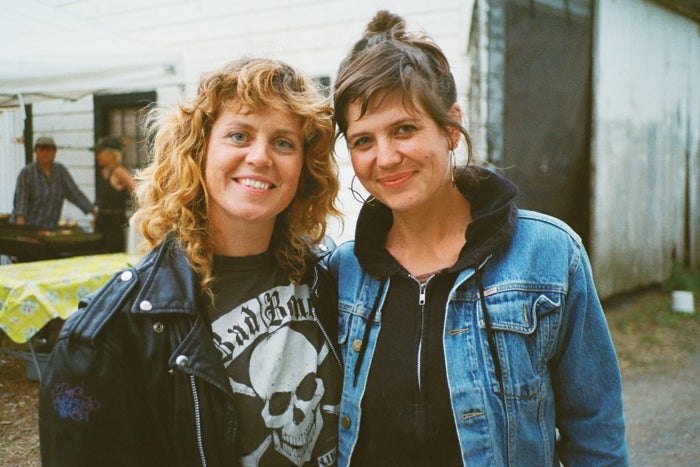
From the beginning, Chase and her wife, Jordan Schmidt (whose own career in the field of food access makes hers an invaluable voice on the farm), had the good fortune of being shepherded in their dairy journey by other like-minded folks who were using new-old ways of stewarding the land and making a living.
Chase was mentored by local sheep farmer Jennifer Phillips, a professor in the environmental studies department at Bard College who imparted knowledge about grazing management and technique. In Sharon Springs, two hours northwest of Pine Plains, she met Paul and Phyllis Van Amburgh, who were hard at work stewarding Dharma Lea Farm—one of the founding farms of Maple Hill Creamery, America’s original 100% grass-fed organic dairy.
“Paul and Phyllis became like a second set of farming parents to us,” says Chase, acknowledging the many ways in which the veteran farmers influenced the young couple. “They recommended old books to read, coached us in grazing management, helped us think about business planning, and geeked out with us about dairy genetics.”
Chase likewise counts her connection to Pine Plains as a huge advantage, as she lives among a circle of local residents with jobs adjacent to dairy farming, including a milk tester and a bulk tank repair person, who have facilitated her transition to owner/operator of Chaseholm Farm and supported her tenure with genuine enthusiasm. In the enclave where Chase lives and works, women are ruling the roost—from her veterinarian and neighboring veggie and livestock farmers to most of her employees.
“We’ve [also] been a queer dairy farm from the get-go, which is great,” Chase says, noting she’s proud to have cultivated an LGBTQIA+ community smack dab in the midst of a place where the queer community, if present when she was growing up, was not visible to her. Many of Chaseholm’s workers also identify as queer, drawn to the ethos of the farm and the values permeating the work being done there.
Over the years, Chase and Schmidt, who married on the farm in 2016, have both given back to the region as thanks for the support and expertise they’ve received. For example, neighbors in need can benefit from Chaseholm Farm products at no cost to them thanks to the Food Sovereignty Fund. Founded by a local nonprofit at the height of the pandemic, the fund is working to increase access to regionally produced food and protect the bottom line of small, regeneratively managed farms led by owners like Chase, who come from historically marginalized backgrounds.
The model creates a win-win by paying Chase a fair price for her products and distributing them at no cost to individuals facing food insecurity. “By working toward something bigger, we’ve made [our life] feel really whole,” she says.
Old Methods, New Problems
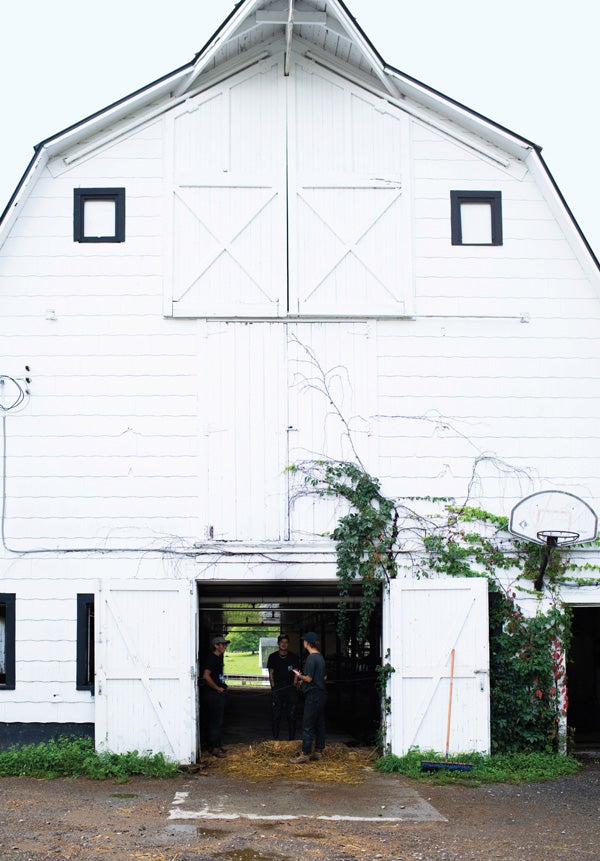
Still, challenges abound. The wealth gap in Dutchess County is big: According to the Economic Policy Institute, income inequality in New York state is sky high. In fact, a 2018 study revealed that among the top 1% of earners in the state, the average income was a whopping 44 times the average income of the remaining 99%—the most extreme disparity nationwide. While many neighbors are struggling to make ends meet, abundant wealth among a certain percentage of the community makes it possible for Chase to make a living, despite the historically daunting economics of dairy farming.
Changing climate conditions can also cause problems. Unpredictability ranks high on Chase’s list, especially when it comes time to make hay. “It used to be easy to find a three-day window without rain,” says Chase, who chuckles aloud recalling stories from “old timers”—not unlike her father—who knew if there was a thunderstorm one afternoon on the farm, they’d be good for four days before the next one rolled through.
Ditto for long-term power outages at the height of summer, which translate to Chase getting up every hour to run her tractor generator in order to keep the walk-in freezer and store coolers running. Rising temperatures are also an issue, considering that the animals are designed to spend their days outside grazing. “If it’s really hot, it becomes too stressful for the cows to remain outdoors,” Chase says.
In the ensuing years, Chase has adapted by ensuring adequate shade in each of the paddocks and putting off milking until noon when necessary to shield the herd from the hottest hours of the day in favor of grazing at night. Chaseholm Farms’ soil is also better equipped to thrive in wet and rainy weather rather than drought conditions—a direct and tangible correlation to Chase’s multi-paddock grazing efforts over the past decade. “Rotating the cows and waiting for grass to fully recover allows deep roots to develop and gives our soil more water-holding capacity, which reduces erosion,” she says. These benefits are slow to dry up, even during a summer 2022 drought.
New Times, New Approaches
In March 2023, as part of the town’s bicentennial, Chase and her father attended the premiere of the documentary Our Farms, Our Farmers, in which they both appeared. In a Q&A following the screening, Barry Chase recalled the once-vibrant farming community for the audience. “Back in the 1940s, there were 40 dairy farms just in Pine Plains,” he told the New Pine Plains Herald, before pointing out that figure has dropped to just four in 2023.
But if Chase’s dad worried about his daughter during the early days of her ownership, he was convinced her approach was the only way forward once she reached the five-year milestone. Ten years in, he’s even more certain.
At Chaseholm Farm, Chase regularly hosts queer-friendly community events like Dairy Drag, which debuted in 2021 during Pride Month to celebrate the Hudson Valley’s diverse population. “It’s a celebration of queerness in a rural space, which feels special because it’s not found all that often [there],” Chase explains of the now-annual drag shows.
I could have done things the way they had been done before—but it wasn’t going to work in a real, sustainable way.
At some point, Chase realized that she was drawing on the skills she gleaned as a bartender-turned-manager at the ’Sco, where she booked bands and helped program Drag Ball. “[Working there] was probably my first go at inventory management and trying to learn about the products we were selling to better serve our customers,” Chase says. Among other helpful habits she developed there: supporting local breweries; late nights counting the till (and having to account for the total); tapping a keg; and asking tough customers to leave.
An Air of Celebration
Just after sunset on a glorious Saturday in late October, with a bonfire blazing and colored lights spilling from within the decades-old dairy barn, a sold-out crowd of more than 200 people gather in the shadow of the towering grain silo for Dairy Drag. Energy is high: It’s Chaseholm Farm’s 2023 season finale, timed well before the snow flies.

A cacophony of voices swells in the dark as attendees nosh on wood-fired pizza, gather at picnic tables, and sip turmeric lattes made with bone broth and whole milk produced on site. In a testament to Chase’s bustling business and entrepreneurial success, a steady stream of foot traffic heads in and out of the farm store buying all manner of provisions—paper sacks of freshly dug onions, sweet potatoes, frozen pork roasts, and beef short ribs.
Local families with young children keep company with visitors from New York City, all of whom delight in coming together in the most unusual of spaces to celebrate life’s simple pleasures and be entertained by veteran performers hailing from various locales including Hudson (a city three times the size of Pine Plains, just 25 miles away) and by a first-timer from The Big Apple. While Chase laughs when asked if she knows all of the people who turn up for Dairy Drag—she does not—she does feel unequivocally supported by her community.
“There’s some spirituality in it for me,” Chase says of having both caused and been able to witness the continued evolution of the very land upon which she was raised. Before long, the crowd begins to move en masse into the barn to fill the stalls recently vacated by cows such as Frau, Mona, Fuss, and Yodel, eager to support a pillar of life in Pine Plains that has nourished and sustained so many.
As dance music drifts through the dusty rafters and the dairy barn’s center aisle becomes a catwalk strewn with crumpled dollar bills, Chase sees multiple layers of meaning. “I’m watching the drag performers, feeling the audience’s energy fill the space while thinking about my father and grandfather milking the cows,” says Chase, reflecting on a career that’s both rooted in her family’s history and distinct from it. “We’ve lived and breathed dairy farming our whole lives, but it’s not the same [as it has been]; every part of it, I have been able to make it my own and make it better for me [and my wife], in the place and time we’re at right now, and what makes sense for our life.”
Chase notes the many things needed to pull off this epic feat—among them something perhaps unexpected: The crimson-hued Boston ivy swathing the barn’s clapboard exterior, heavy with clusters of blue-black fruit, boasts broad perennial leaves that create a living green barrier between the slanting autumn sun and her one-of-a-kind herd.
Ultimately, Chase is proud of and grateful for her life “on this farm, on this land” and what it represents. “I could have done things the way they had been done before—but it wasn’t going to work in a real, sustainable way.”
This story originally appeared in the Winter/Spring 2024 issue of the Oberlin Alumni Magazine.
You may also like…
Coming Full Circle
Under Finney’s vaulted ceilings, the orchestra, several star vocal soloists, and the conservatory’s vocal ensembles—including the Oberlin College Choir, Oberlin Gospel Choir, and Oberlin Musical Union...
Treasure Hunting
A peek into the expansive world of Tony-winning costume designer Montana Levi Blanco '07.
Telling (Love) Stories
Author Dominic Lim ’96 educates readers through romance with the novel Karaoke Queen.


